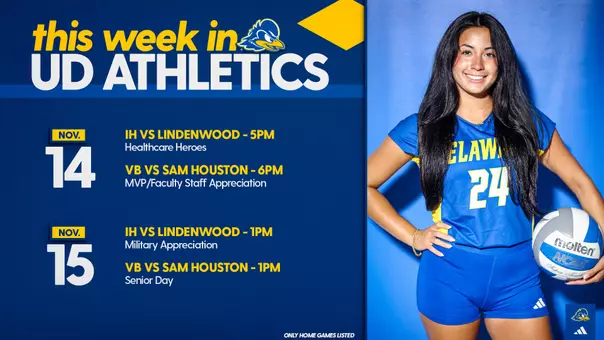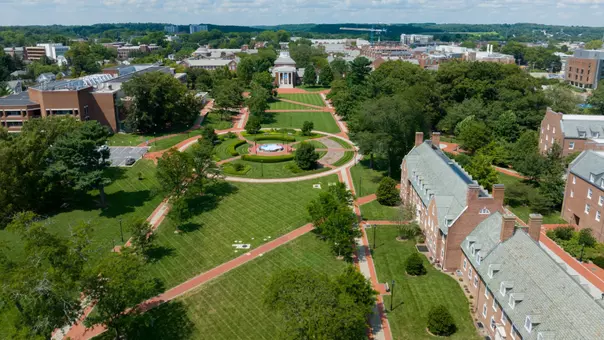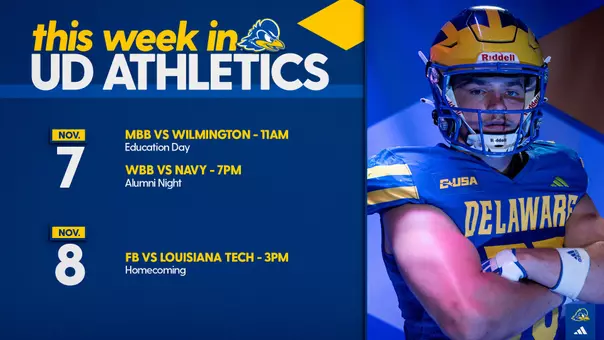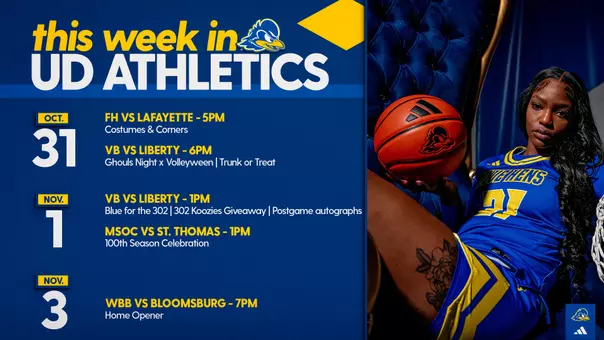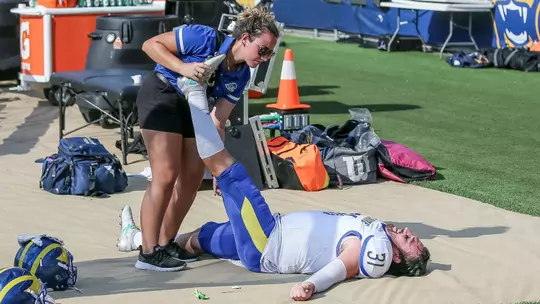
Blue Hens Across Campus Collaborate To Produce Wearable Technology For Hamstring Recovery
Andy Lohman
8/19/2020
What do you do if you’re an athletic trainer looking for new wearable technology to aid your athletes in recovery from injury? If you’re at the University of Delaware, you don’t even have to leave campus for the solution.
Brandon DeSantis, Associate Athletic Director and Head Football Athletic Trainer, and his colleagues were looking for a more elegant device for athletes that were returning to practice after a hamstring strain. Their previous solution was to affix a resistance band to an athlete’s leg with a combination of tape, wraps and a football belt around the waist.
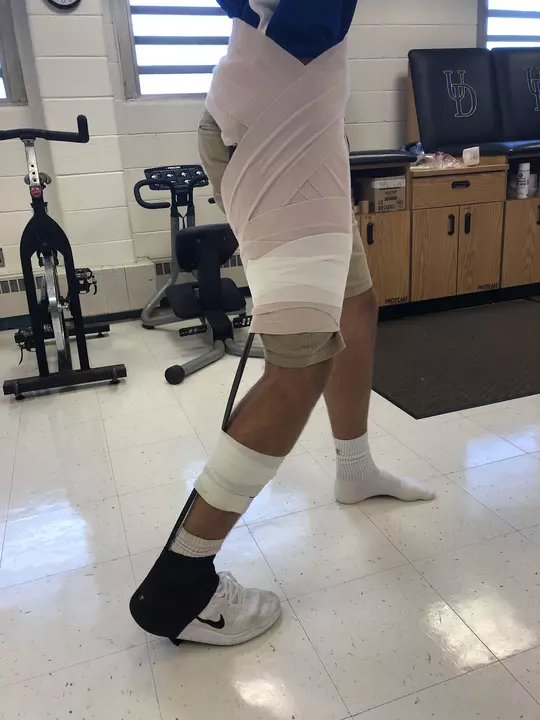
“As we’re progressing back to practice, it helps get people back a lot faster,” DeSantis said. “It prevents them from hyperextending, it gives them a little bit more cueing that they shouldn’t really open up their stride fully, and just gives them some extra protection.”
The apparatus worked, but took two clinicians, in addition to the athlete, to put on, and was rather clunky to wear.
DeSantis, partnered with Director of Innovation for the College of Health Sciences Martha Hall, presented the challenge to improve the device as an option for the College of Engineering’s senior design course in the fall of 2019.
“Senior design is a good way to really get our seniors, our highly qualified students, our engineers-in-training, their first exposure to a real-world project,” Adam Wickenheiser, Associate Professor in the College of Engineering and the advisor for the project said. “I would say ‘real world’ meaning that the sponsor isn’t necessarily an engineer, so they don’t come knowing how to do this or knowing exactly what they want; they have sort of a vision.”
A group of four senior engineers, Madison Knox, Melody Cerro, Joseph Lockard and Jacob Lubsen, completed the entire design process over the course of the intense, six-credit, semester-long class. After gathering information and brainstorming several solutions, the group eventually produced and tested a prototype device.

While the original athletic training device was really just a hodge-podge of tape and wrap, the group’s final design was one solid piece that athletes can put on themselves in under a minute. A hip brace is sewn to a thigh compression sleeve, while a resistance band is connected to an ankle sleeve, with several D-rings on the waist allowing for size adjustments.
“It’s a lot less cumbersome, it’s a lot sleeker. It’s just a better design,” DeSantis said.

The athletic training staff really liked the prototype, but wanted more than just the one to continue testing for student-athlete use. So, in February DeSantis attended the HensWEAR Symposium, an event designed to foster a community of researchers at UD focused on smart wearables, to find a solution to produce more of the hamstring devices. There, he connected with Katya Roelse, who runs the Fashion & Apparel Studies Flex Factory, which is a part of the UD MakerNetwork.
“It’s a small lab with sort of robust or industrial machinery, not home sewing machines, where my intention is to make it a space where students can learn these additional sewing skills and experience this factory process, because it’s a whole different thing, and actually get paid to learn this and to produce things,” Roelse said of the Flex Factory.
Roelse liked the idea of taking on the hamstring device production, as it gave her students an opportunity to get experience with products that aren’t typically associated with fashion, but still have a real-world impact. Her team streamlined the design by taking away some of the rings and tabs that were unnecessary to the function of the device and made it clunky.
From there, Roelse acts as the facilitator, ordering supplies, organizing the division of labor among the students, and ultimately delivering the final product to DeSantis in athletic training. Since the COVID-19 pandemic hit right as production was getting underway, the students have had to adapt to working with the industrial machinery at home. Each student works on a different component of the device, essentially creating a socially distanced assembly line across Newark and Wilmington.
With fashion, it's more than just pretty clothes.Katya Roelse
Mandy Rai is a junior Apparel Design major from Wilmington who is in charge of fastening the D-rings to the belt.
“I’m in charge of making sure that this doesn’t fall off of someone who is wearing it, I have to make sure it’s sturdy,” Rai said. “I think that was the cool part, is that all three people have to work together in order to make one product.”
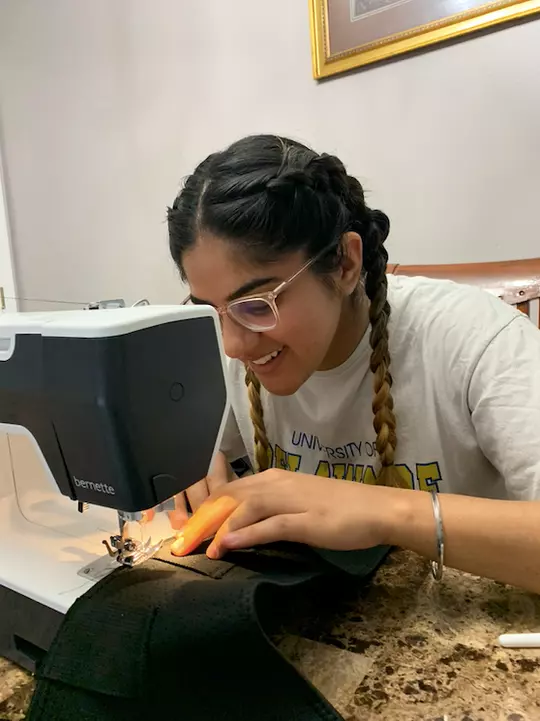
The project shows the wonderful results when the different communities within UD come together to work collaboratively towards a solution. Three entities that normally wouldn’t be associated with each other (athletics, engineering, and fashion) operated to solve a problem in a way that ended up being beneficial for all. Athletic training gets a cost-effective wearable technology, engineering students get to experience designing for a real-world client, and fashion students get to use new tools to make a product they otherwise would not have heard of.
“The communication of being able to talk to the non-technical people, and then bridge that gap. The non-technical people that are sponsoring, they know what they want, but they don’t know if it’s possible to do it in any particular way or another,” Wickenheiser said of the benefit of collaboration for engineering students. “It’s great that they were able to do a lot of field research. Even though it’s still on campus, they were going outside the bubble of the College of Engineering and going down to the athletic facilities. They were interviewing athletes, doing testing, having them wear the device and run around on the field and go through the motions of practice.”

“With fashion, it’s more than just pretty clothes,” Roelse said. “It’s the products we put into our lives and they have meaning behind them. They have to be made well, they have to function, they have to look pleasing. But when you collaborate with someone, especially someone outside of your discipline, it benefits all sides because we’re all bringing something to the table.”
“Everyone really just does have a common goal of producing new and innovative wearable devices, whether it’s for athletes, or the general population, or special populations,” DeSantis said. “We got connected with [HensWEAR] and since then we’ve been working on creating different things. We’ve had a couple different prototypes for a couple different projects, but it’s stuff that we wouldn’t be able to do on our own.”

